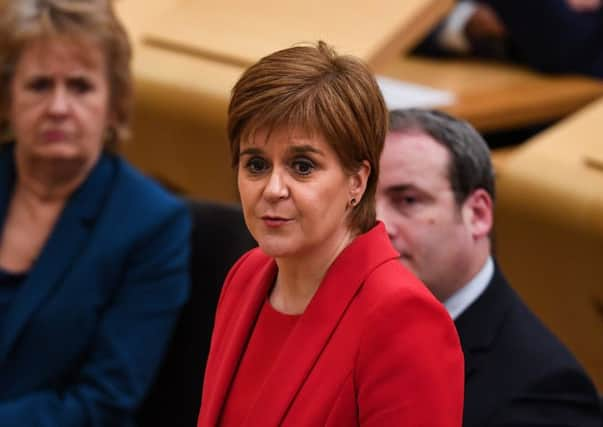Timeline: Has Nicola Sturgeon’s position on a second independence referendum changed?


In the months following the EU referendum, the First Minister has had much to say on the SNP’s core belief and how it could offer Scots a possible path back to Europe.
It’s fair to say her position has evolved over the past two and a half years, leading to yesterday’s clash with Prime Minister Theresa May.
Advertisement
Hide AdAdvertisement
Hide AdThe SNP leader used a meeting at Downing Street to insist that Scotland is not only ready for a second independence referendum, but that the Scottish Parliament should be given the powers from Westminster to hold one.
It is a marked change from the “pause” she promised voters in nascent plans for a second referendum after the SNP suffered damaging losses in the snap general election of 2017.
After the Brexit vote
The SNP had made noises even before the shock result of the referendum on leaving the EU about Scotland ‘being dragged out of the EU against our will’.
Results from across the country showed that all of Scotland’s 32 local authorities voted to remain in the EU, a 62-38 win for the ‘in’ campaign.
In a statement after the vote, Ms Sturgeon said that a second referendum was now ‘highly likely’ and that it was ‘democratically unacceptable’ for Scotland to leave the EU.
The First Minister also said there was ‘significant divergence’ between Scotland and the rest of the UK.
Called and rejected
After a summer of upheaval following the Brexit vote in 2016, Ms Sturgeon promised the party faithful at the SNP’s conference in the autumn that work would commence on a new referendum bill.
In March 2017, after a narrow vote in the Scottish Parliament, MSPs endorsed Nicola Sturgeon’s plan to call for the UK Government to transfer the legal authority to hold a referendum to Holyrood.
Advertisement
Hide AdAdvertisement
Hide AdAnnouncing that move, Ms Sturgeon said: “I will now take the steps necessary to make sure that Scotland will have a choice at the end of this process, a choice of whether to follow the UK to a hard Brexit or to become an independent country, able to secure a real partnership of equals with the rest of the UK and our own relationship with Europe.”
Following that vote, the First Minister wrote to Theresa May asking for that power to be transferred, telling the Prime Minister it would be “democratically indefensible and utterly unsustainable” to deny the Scottish Government the right to hold a vote.
That plea fell on deaf ears, with David Mundell, Secretary of State for Scotland, declaring almost instantly that the request would be denied.
The pause
The Spring of 2017 proved to be far from a season in the sun for the independence movement.
Fresh off rejecting the demands of Nicola Sturgeon, Theresa May shocked the political establishment in Britain by calling a snap general election, at which her party lost their majority.
In Scotland, however, the Tories had a hugely successful night, swelling their ranks at Westminster from just a single MP to 14, after running a campaign focussed on rejecting independence.
Nicola Sturgeon said her plans for a second referendum were ‘undoubtedly’ a factor in the SNP’s loss of 21 seats across the country.
She also pledged to ‘reflect carefully’ on the result, which saw party stalwarts like Angus Robertson and Alex Salmond lose their seats.
Advertisement
Hide AdAdvertisement
Hide AdThat eventually lead to her announcement in June of 2017 of a ‘pause’ in plans for a second referendum.
She told MSPs: “The Scottish government will reset the plan. We will not seek to introduce the legislation for a second referendum immediately.”
The revival
That pause lasted through the rest of 2017, and through the first half of 2018, with Ms Sturgeon even using an interview in June of last year to say that supporters and opponents of independence alike should stop ‘obsessing’ about the timing of a new poll.
She told the BBC: “Let’s stop obsessing all the time about when we might get the chance to vote on independence again. Instead, let’s engage people in the substantive arguments. Let’s address people who still ask the question why should Scotland be independent.”
However, by the time of the party’s Autumn conference, the tone seemed to have changed again.
Under pressure from restless activists, who staged several large demonstrations in Scotland’s major cities to support independence, Ms Sturgeon again spelled out why independence was preferable to Brexit in her view.
She told delegates: “But as we wait – impatiently, at times, I know – for this phase of negotiations to conclude and for the fog of Brexit to clear, be in no doubt about this. The last two years have shown why Scotland needs to be independent.”
The present
That impatience described by the First Minister has become more and more apparent since that speech in October, and indeed since Theresa May’s Brexit deal collapsed around her.
Advertisement
Hide AdAdvertisement
Hide AdIt is with greater urgency that Nicola Sturgeon has pursued the cause of independence in recent weeks, even telling journalists yesterday that the Prime Minister was ‘running scared’ over the constitutional issue.
Some of the old battles of the 2014 vote are being re-run too, with a row over legal advice given to the Scottish Government.
It is undeniable that Nicola Sturgeon has been flexible with her position on independence since the UK (but not Scotland) voted to leave the EU in 2016.
With the date of departure fast approaching, it may yet have to remain that way.
